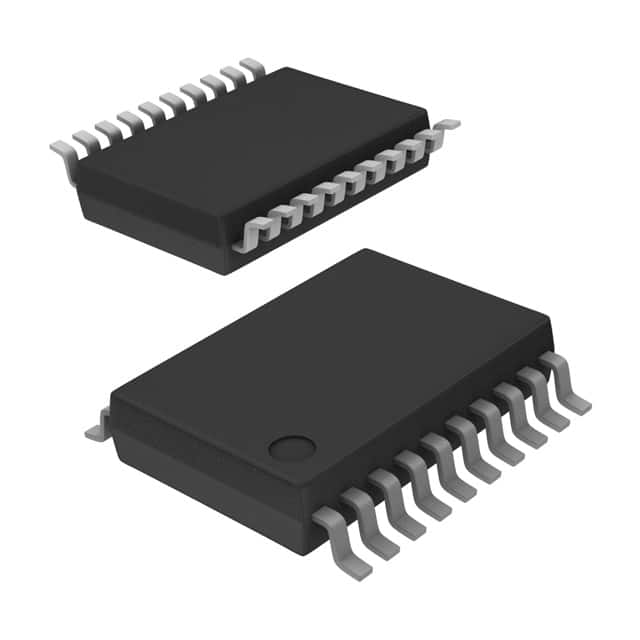Xem thông số kỹ thuật để biết chi tiết sản phẩm.

SN74LVT245BDBRE4
Product Overview
- Category: Integrated Circuit (IC)
- Use: Level Shifter/Transceiver
- Characteristics: High-speed, low-power, bidirectional voltage level translation
- Package: SSOP (Shrink Small Outline Package)
- Essence: Voltage level shifting and signal transmission between different logic levels
- Packaging/Quantity: Tape and Reel, 2500 units per reel
Specifications
- Logic Family: LVT (Low-Voltage TTL)
- Number of Channels: 8
- Input Voltage Range: 1.2V to 3.6V
- Output Voltage Range: 1.2V to 3.6V
- Propagation Delay: 3.5 ns (typical)
- Operating Temperature Range: -40°C to +85°C
Detailed Pin Configuration
The SN74LVT245BDBRE4 has a total of 20 pins. The pin configuration is as follows:
- OE (Output Enable) 1
- A1 (Data Input/Output) 1
- A2 (Data Input/Output) 1
- A3 (Data Input/Output) 1
- A4 (Data Input/Output) 1
- A5 (Data Input/Output) 1
- A6 (Data Input/Output) 1
- A7 (Data Input/Output) 1
- GND (Ground)
- B7 (Data Input/Output) 2
- B6 (Data Input/Output) 2
- B5 (Data Input/Output) 2
- B4 (Data Input/Output) 2
- B3 (Data Input/Output) 2
- B2 (Data Input/Output) 2
- B1 (Data Input/Output) 2
- VCC (Power Supply)
- DIR (Direction Control)
- OE (Output Enable) 2
- GND (Ground)
Functional Features
- Bidirectional voltage level translation between two logic levels
- High-speed operation with low propagation delay
- Supports voltage translation from 1.2V to 3.6V
- Enables interfacing between different logic families
- Provides direction control for data transmission
Advantages and Disadvantages
Advantages: - High-speed operation allows for efficient data transfer - Low-power consumption for energy-efficient applications - Wide input/output voltage range enables compatibility with various devices - Bidirectional functionality simplifies circuit design
Disadvantages: - Limited number of channels (8) may not be sufficient for complex systems - Requires careful consideration of voltage compatibility to prevent damage
Working Principles
The SN74LVT245BDBRE4 is a bidirectional level shifter/transceiver that facilitates the translation of voltage levels between two logic families. It operates by receiving data inputs from one logic level and translating them to the corresponding voltage level of the other logic level. The direction control pin (DIR) determines the direction of data transmission, allowing for both input and output functionality.
The device utilizes a combination of MOSFETs and CMOS technology to achieve high-speed operation with minimal power consumption. It is designed to provide reliable and efficient voltage level shifting while maintaining signal integrity.
Detailed Application Field Plans
The SN74LVT245BDBRE4 finds applications in various fields where voltage level translation is required. Some potential application areas include:
- Microcontroller Interfacing: Facilitating communication between microcontrollers operating at different voltage levels.
- Sensor Networks: Enabling data exchange between sensors and microcontrollers with varying logic levels.
- Communication Systems: Supporting voltage level translation in communication interfaces such as UART, SPI, and I2C.
- Industrial Automation: Integrating different control systems with varying logic levels for seamless operation.
Detailed and Complete Alternative Models
- SN74LVC245APW: Similar functionality with a different package (TSSOP)
- SN74LVCH245ADGVR: Bi-directional level shifter with 3-state outputs
- SN74AVC4T245PWR: Quad-bit level shifter with configurable voltage translation
These alternative models offer similar voltage level shifting capabilities but may differ in terms of package type, number of channels, or additional features. It is important to consider the specific requirements of the application when selecting an alternative model.
Word count: 536 words
Liệt kê 10 câu hỏi và câu trả lời thường gặp liên quan đến ứng dụng SN74LVT245BDBRE4 trong giải pháp kỹ thuật
Sure! Here are 10 common questions and answers related to the application of SN74LVT245BDBRE4:
Q: What is SN74LVT245BDBRE4? A: SN74LVT245BDBRE4 is a bidirectional octal bus transceiver with 3-state outputs, commonly used for level shifting and voltage translation in digital systems.
Q: What is the operating voltage range of SN74LVT245BDBRE4? A: SN74LVT245BDBRE4 operates within a voltage range of 1.65V to 3.6V.
Q: How many bidirectional channels does SN74LVT245BDBRE4 have? A: SN74LVT245BDBRE4 has 8 bidirectional channels, allowing for simultaneous data transmission in both directions.
Q: What is the maximum data transfer rate supported by SN74LVT245BDBRE4? A: SN74LVT245BDBRE4 supports a maximum data transfer rate of 400 Mbps.
Q: Can SN74LVT245BDBRE4 be used for voltage level shifting between different logic families? A: Yes, SN74LVT245BDBRE4 can be used for voltage level shifting between different logic families, such as TTL and CMOS.
Q: Does SN74LVT245BDBRE4 have built-in ESD protection? A: Yes, SN74LVT245BDBRE4 has built-in ESD protection, making it more robust against electrostatic discharge events.
Q: What is the power supply current consumption of SN74LVT245BDBRE4? A: The power supply current consumption of SN74LVT245BDBRE4 is typically around 10 mA.
Q: Can SN74LVT245BDBRE4 be used in hot-swapping applications? A: Yes, SN74LVT245BDBRE4 supports hot-swapping, allowing for safe insertion and removal of the device while the system is powered.
Q: What is the package type of SN74LVT245BDBRE4? A: SN74LVT245BDBRE4 is available in a TSSOP-20 package.
Q: Are there any recommended decoupling capacitors for SN74LVT245BDBRE4? A: Yes, it is recommended to use a 0.1 µF decoupling capacitor placed close to the power supply pins of SN74LVT245BDBRE4 to ensure stable operation.
Please note that these answers are general and may vary depending on specific application requirements. Always refer to the datasheet and application notes for accurate information.

